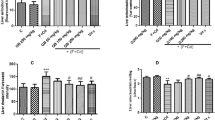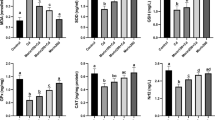Abstract
Heavy metal contamination including mercury (Hg) has become one of the most serious environmental problems facing humans and other living organisms. Here, the hepatoprotective effects of Z. spina-christi leaf extract (ZCE) against inorganic mercury salt (mercuric chloride; HgCl2)–induced hepatotoxicity model was investigated in rats. Mercury concentration, liver function markers, oxidative stress markers, inflammation, cell death indicators, and histopathology were assessed. ZCE protected against HgCl2-induced hepatotoxicity, decreased Hg concentration, lipid peroxidation, and nitric oxide, increased glutathione, superoxide dismutase, catalase, and glutathione recycling enzymes (peroxidase and reductase), and upregulated nuclear factor-erythroid 2-related factor 2 (Nrf2) gene expression in HgCl2-intoxicated rat hepatic tissue. Nrf2 downstream gene and heme oxygenase-1 were also upregulated, confirming that hepatoprotection by ZCE against HgCl2-induced liver damage involved activation of the Nrf2/antioxidant response element pathway. ZCE also decreased the expression and production of pro-inflammatory cytokines and pro-apoptotic proteins and increased anti-apoptotic protein Bcl-2. Immunohistochemical analysis of liver tissues of HgCl2-treated rats confirmed the alternations of apoptotic-related protein expression. Our data demonstrated that post-administration of ZCE attenuated HgCl2-induced liver damage by activating the Nrf2/HO-1 signaling pathway. Therefore, administering this extract may be a novel therapeutic strategy for inorganic mercury intoxication.









Similar content being viewed by others
Data availability
All relevant data are within the paper.
References
Abdel Moneim AE (2013) The neuroprotective effects of purslane (Portulaca oleracea) on rotenone-induced biochemical changes and apoptosis in brain of rat. CNS Neurol Disord Drug Targets 12(6):830–841. https://doi.org/10.2174/18715273113129990081
Abdel Moneim AE (2016) Indigofera oblongifolia prevents lead acetate-induced hepatotoxicity, oxidative stress, fibrosis and apoptosis in rats. PLoS One 11:e0158965. https://doi.org/10.1371/journal.pone.0158965
Aebi H (1984) Catalase in vitro. Methods Enzymol 105:121–126
Alajmi RA, Al-Megrin WA, Metwally D, Al-Subaie H, Altamrah N, Barakat AM, Abdel Moneim AE, Al-Otaibi TT, El-Khadragy M (2019) Anti-toxoplasma activity of silver nanoparticles green synthesized with Phoenix dactylifera and Ziziphus spina-christi extracts which inhibits inflammation through liver regulation of cytokines in Balb/c mice. Biosci Rep 39:BSR20190379. https://doi.org/10.1042/bsr20190379
Almeer RS, El-Khadragy MF, Abdelhabib S, Abdel Moneim AE (2018a) Ziziphus spina-christi leaf extract ameliorates schistosomiasis liver granuloma, fibrosis, and oxidative stress through downregulation of fibrinogenic signaling in mice. PLoS One 13:e0204923. https://doi.org/10.1371/journal.pone.0204923
Almeer RS, Mahmoud SM, Amin HK, Abdel Moneim AE (2018b) Ziziphus spina-christi fruit extract suppresses oxidative stress and p38 MAPK expression in ulcerative colitis in rats via induction of Nrf2 and HO-1 expression. Food Chem Toxicol. https://doi.org/10.1016/j.fct.2018.03.002
Araujo J, Zhang M, Yin F (2012) Heme oxygenase-1, oxidation, inflammation, and atherosclerosis. Front Pharmacol 3:119. https://doi.org/10.3389/fphar.2012.00119
Baxter DC, Frech W (1989) Determination of mercury by atomic absorption spectrometry using a platinum-lined graphite furnace for in situ preconcentration. Anal Chim Acta 225:175–183. https://doi.org/10.1016/S0003-2670(00)84605-X
Cherrak SA, Mokhtari-Soulimane N, Berroukeche F, Bensenane B, Cherbonnel A, Merzouk H, Elhabiri M (2016) In vitro antioxidant versus metal ion chelating properties of flavonoids: a structure-activity investigation. PLoS One 11:e0165575
Choi J-Y, Won NH, Park JD, Jang S, Eom C-Y, Choi Y, Park YI, Dong M-S (2016) From the cover: ethylmercury-induced oxidative and endoplasmic reticulum stress-mediated autophagic cell death: involvement of autophagosome–lysosome fusion arrest. Toxicol Sci 154:27–42. https://doi.org/10.1093/toxsci/kfw155
Corrêa Costa M, Amano MT, Câmara NO (2012) Cytoprotective role of heme oxygenase-1 upregulation in progressive renal disease. World J Nephrol 1(1):4–11
Culbreth M, Zhang Z, Aschner M (2017) Methylmercury augments Nrf2 activity by downregulation of the Src family kinase Fyn. Neurotoxicology 62:200–206 doi:S0161-813X(17)30158-4
De Vega L, Fernandez RP, Mateo MC, Bustamante JB, Herrero AM, Munguira EB (2002) Glutathione determination and a study of the activity of glutathione-peroxidase, glutathione-transferase, and glutathione-reductase in renal transplants. Ren Fail 24:421–432
Dkhil MA, Al-Quraishy S, Moneim AEA (2018a) Ziziphus spina-christi leaf extract pretreatment inhibits liver and spleen injury in a mouse model of sepsis via anti-oxidant and anti-inflammatory effects. Inflammopharmacology 26:779–791. https://doi.org/10.1007/s10787-017-0439-8
Dkhil MA, Kassab RB, Al-Quraishy S, Abdel-Daim MM, Zrieq R, Abdel Moneim AE (2018b) Ziziphus spina-christi (L.) leaf extract alleviates myocardial and renal dysfunction associated with sepsis in mice. Biomed Pharmacother 102:64–75. https://doi.org/10.1016/j.biopha.2018.03.032
Elaloui M, Ghazghazi H, Ennajah A, Manaa S, Guezmir W, Karray NB, Laamouri A (2017) Phenolic profile, antioxidant capacity of five Ziziphus spina-christi (L.) Willd provenances and their allelopathic effects on Trigonella foenum-graecum L. and Lens culinaris L. seeds. Nat Prod Res 31:1209–1213. https://doi.org/10.1080/14786419.2016.1226830
Elblehi SS, Hafez MH, El-Sayed YS (2019) L-α-Phosphatidylcholine attenuates mercury-induced hepato-renal damage through suppressing oxidative stress and inflammation. Environ Sci Pollut Res 26:9333–9342. https://doi.org/10.1007/s11356-019-04395-9
Ellman GL (1959) Tissue sulfhydryl groups. Arch Biochem Biophys 82:70–77
Ferrer-Sueta G, Radi R (2009) Chemical biology of peroxynitrite: kinetics, diffusion, and radicals. ACS Chem Biol 4:161–177. https://doi.org/10.1021/cb800279q
Green LC, Wagner DA, Glogowski J, Skipper PL, Wishnok JS, Tannenbaum SR (1982) Analysis of nitrate, nitrite, and [15N]nitrate in biological fluids Anal Biochem 126:131-138 doi:0003-2697(82)90118-X
Hazelhoff MH, Torres AM (2018) Gender differences in mercury-induced hepatotoxicity: potential mechanisms. Chemosphere 202:330–338. https://doi.org/10.1016/j.chemosphere.2018.03.106
Jaishankar M, Tseten T, Anbalagan N, Mathew BB, Beeregowda KN (2014) Toxicity, mechanism and health effects of some heavy metals. Interdiscip Toxicol 7:60–72. https://doi.org/10.2478/intox-2014-0009
Jiang X, Gu S, Liu D, Zhao L, Xia S, He X, Chen H, Ge J (2018) Lactobacillus brevis 23017 relieves mercury toxicity in the colon by modulation of oxidative stress and inflammation through the interplay of MAPK and NF-κB signaling cascades. Front Microbiol 9. https://doi.org/10.3389/fmicb.2018.02425
Lee J, Lee SJ, Lim KT (2014) Preventive effects of ZPDC glycoprotein (24 kDa) on hepatotoxicity induced by mercury chloride in vitro and in vivo. Cell Biochem Funct 32:520–529. https://doi.org/10.1002/cbf.3046
Levings DC, Wang X, Kohlhase D, Bell DA, Slattery M (2018) A distinct class of antioxidant response elements is consistently activated in tumors with NRF2 mutations. Redox Biol 19:235–249. https://doi.org/10.1016/j.redox.2018.07.026
Liu W, Xu Z, Li H, Guo M, Yang T, Feng S, Xu B, Deng Y (2016) Protective effects of curcumin against mercury-induced hepatic injuries in rats, involvement of oxidative stress antagonism, and Nrf2-ARE pathway activation. Hum Exp Toxicol 36:949–966. https://doi.org/10.1177/0960327116677355
Liu W, Yang T, Xu Z, Xu B, Deng Y (2019) Methyl-mercury induces apoptosis through ROS-mediated endoplasmic reticulum stress and mitochondrial apoptosis pathways activation in rat cortical neurons. Free Radic Res 53:26–44. https://doi.org/10.1080/10715762.2018.1546852
Livak KJ, Schmittgen TD (2001) Analysis of relative gene expression data using real-time quantitative PCR and the 2(-Delta Delta C(T)) Method. Methods 25:402–408. https://doi.org/10.1006/meth.2001.1262
Moneim AE (2015) Mercury-induced neurotoxicity and neuroprotective effects of berberine. Neural Regen Res 10:881–882. https://doi.org/10.4103/1673-5374.158336
Nguyen T, Nioi P, Pickett CB (2009) The Nrf2-antioxidant response element signaling pathway and its activation by oxidative stress. J Biol Chem 284:13291–13295. https://doi.org/10.1074/jbc.R900010200
Nishikimi M, Appaji N, Yagi K (1972) The occurrence of superoxide anion in the reaction of reduced phenazine methosulfate and molecular oxygen. Biochem Biophys Res Commun 46:849–854
Ohkawa H, Ohishi N, Yagi K (1979) Assay for lipid peroxides in animal tissues by thiobarbituric acid reaction. Anal Biochem 95:351–358
Othman MS, Safwat G, Aboulkhair M, Abdel Moneim AE (2014) The potential effect of berberine in mercury-induced hepatorenal toxicity in albino rats Food Chem Toxicol 69:175-181 doi:S0278-6915(14)00194-X
Pollard KM, Cauvi DM, Toomey CB, Hultman P, Kono DH (2019) Mercury-induced inflammation and autoimmunity. Biochim Biophys Acta Gen Subj:129299. https://doi.org/10.1016/j.bbagen.2019.02.001
Saied AS, Gebauer J, Hammer K, Buerkert A (2008) Ziziphus spina-christi (L.) Willd.: a multipurpose fruit tree. Genet Resour Crop Evol 55:929–937. https://doi.org/10.1007/s10722-007-9299-1
Shen X, Tang Y, Yang R, Yu L, Fang T, Duan JA (2009) The protective effect of Zizyphus jujube fruit on carbon tetrachloride-induced hepatic injury in mice by anti-oxidative activities. J Ethnopharmacol 122:555–560. https://doi.org/10.1016/j.jep.2009.01.027
Singh V, Guizani N, Essa MM, Rahman MS, Selvaraju S (2012) In vitro antioxidant activities of Ziziphus spina-christi Fruits (Red Date) grown in Oman. Biotechnology 11
Singh V et al (2018) Protective effect of Zizyphus spinachristi on MPP+-induced oxidative stress. Front Biosci 10:285–299
Teixeira FB, de Oliveira A, Leão L, Fagundes N, Fernandes RM, Fernandes L, da Silva M, Amado LL, Sagica F, de Oliveira E, Crespo-Lopez ME, Maia C, Lima RR (2018) Exposure to inorganic mercury causes oxidative stress, cell death, and functional deficits in the motor cortex. Front Mol Neurosci 11. https://doi.org/10.3389/fnmol.2018.00125
Ung CY, Lam SH, Hlaing MM, Winata CL, Korzh S, Mathavan S, Gong Z (2010) Mercury-induced hepatotoxicity in zebrafish: in vivo mechanistic insights from transcriptome analysis, phenotype anchoring and targeted gene expression validation. BMC Genomics 11:212. https://doi.org/10.1186/1471-2164-11-212
Uzunhisarcikli M, Aslanturk A, Kalender S, Apaydin FG, Bas H (2015) Mercuric chloride induced hepatotoxic and hematologic changes in rats: the protective effects of sodium selenite and vitamin E. Toxicol Ind Health 32:1651–1662. https://doi.org/10.1177/0748233715572561
Weydert CJ, Cullen JJ (2010) Measurement of superoxide dismutase, catalase and glutathione peroxidase in cultured cells and tissue. Nat Protoc 5:51–66 doi:nprot.2009.197
Wu Q, Li WK, Zhou ZP, Li YY, Xiong TW, Du YZ, Wei LX, Liu J (2016) The Tibetan medicine Zuotai differs from HgCl2 and MeHg in producing liver injury in mice. Regul Toxicol Pharmacol 78:1–7. https://doi.org/10.1016/j.yrtph.2016.03.017
Yang D, Tan X, Lv Z, Liu B, Baiyun R, Lu J, Zhang Z (2016) Regulation of Sirt1/Nrf2/TNF-α signaling pathway by luteolin is critical to attenuate acute mercuric chloride exposure induced hepatotoxicity. Sci Rep 6:37157. https://doi.org/10.1038/srep37157
Yang Q, Li Z, Lu X, Duan Q, Huang L, Bi J (2018) A review of soil heavy metal pollution from industrial and agricultural regions in China: pollution and risk assessment. Sci Total Environ 642:690–700 doi:S0048-9697(18)32139-9
Zhang H, Tan X, Yang D, Lu J, Liu B, Baiyun R, Zhang Z (2017) Dietary luteolin attenuates chronic liver injury induced by mercuric chloride via the Nrf2/NF-kappaB/P53 signaling pathway in rats. Oncotarget 8:40982–40993. https://doi.org/10.18632/oncotarget.17334
Funding
The authors would like to extend their sincere appreciation to the Researchers Supporting Project number: RSP-2020/96, King Saud University, Riyadh, Saudi Arabia.
Author information
Authors and Affiliations
Contributions
Saad Alkahtani, Saud Alarifi, and Gadah Albasher: data curation, resources, validation, writing—original draft. Rafa S. Almeer: conceptualization, data curation, writing—original draft, supervision, resources, validation. Shimaa S. Ramadan: investigation, writing—review and editing. Ahmed E. Abdel Moneim: conceptualization, methodology, data curation, writing—original draft, visualization, investigation, supervision, writing—review and editing
Corresponding author
Ethics declarations
Ethics approval
All procedures were approved by the Committee of Research Ethics for Laboratory Animal Care, Faculty of Science, Helwan University (approval no. HU2018/Z/011-3).
Conflict of interest
The authors declare that they have no conflict of interest.
Consent for publication
All authors consent to publish the study in Environmental Science and Pollution Research.
Additional information
Responsible Editor: Mohamed M. Abdel-Daim
Publisher’s note
Springer Nature remains neutral with regard to jurisdictional claims in published maps and institutional affiliations.
Rights and permissions
About this article
Cite this article
Ramadan, S.S., Almeer, R.S., Alkahtani, S. et al. Ziziphus spina-christi leaf extract attenuates mercuric chloride-induced liver injury in male rats via inhibition of oxidative damage. Environ Sci Pollut Res 28, 17482–17494 (2021). https://doi.org/10.1007/s11356-020-12160-6
Received:
Accepted:
Published:
Issue Date:
DOI: https://doi.org/10.1007/s11356-020-12160-6




